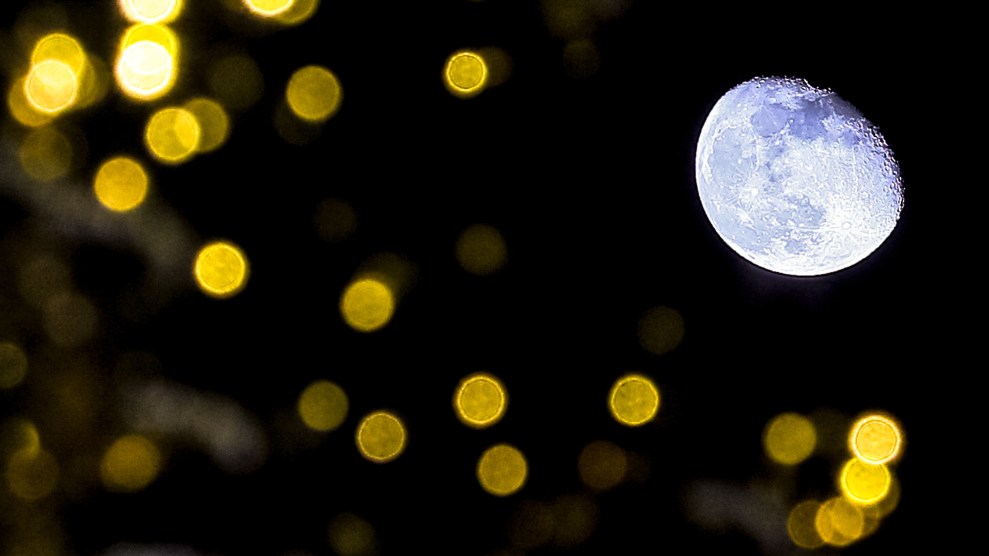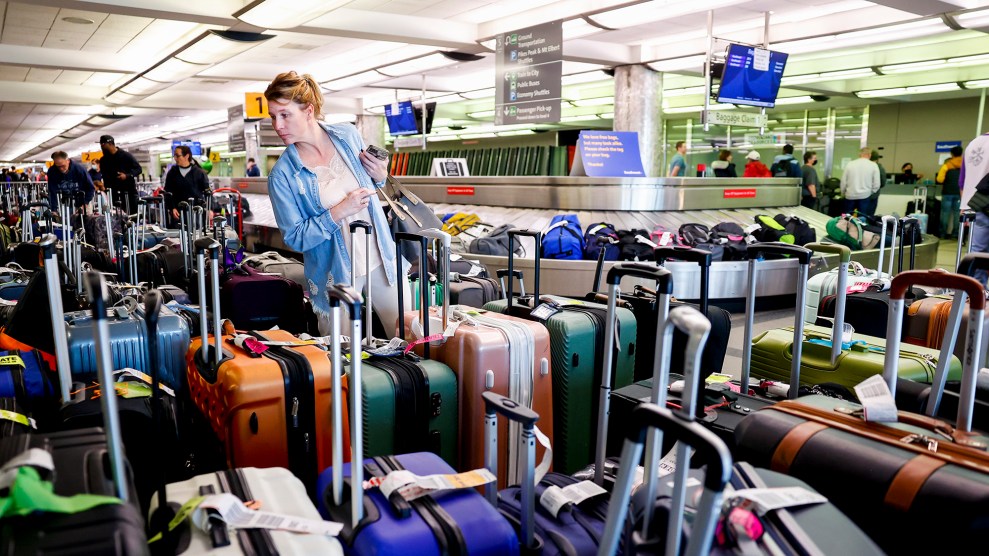Act One. Scene One. It is late afternoon in New York City on the steps of St. Patrick’s Cathedral, a block away from Radio City Music Hall, where the 54th annual Tony Awards will begin in a few hours. Scores of tourists are milling about, taking in the sights, when a group of 10 people in gorilla masks and black capes turns the corner and stops in front of the church. They reach into shopping bags and start handing out cards that say,
“Know your theater lingo:
Plot: White guy writes play; it gets produced.
Subplot: Less than 18 percent of plays produced in the US this season were written by women or people of color.
Farce: Last season was just as bad.
Tragedy: The lack of diversity in theater.”
As if on cue, another group emerges from the wings of the cathedral — around a dozen women and men dressed in black fishnet stockings, combat boots, and black- and-silver cheerleading outfits with the word “art” emblazoned across the front. They are the politico-performance group Art Cheerleaders from Boston. They stand in rows of three, hands on hips. One of them claps and yells, pep-rally style, “Ready, let’s go!”
“So Broadway,” they shout in unison, “Abandon your old-boys’ club. / The Great White Wall has to come down. / Honor new diverse creations. / What about women, people of color? / That’s right! Women, people of color. / 1-2-3-4! / Open your doors to new perspectives. / End your sexist racist practice!”
A crowd gathers and looks on delightedly. This is New York, and they are having a New York experience! They call for an encore. Meanwhile, the people in the simian masks distribute paper bags with eyeholes and a picture of a gorilla on the front and the words “I’m a Guerrilla Girl. Your Cultural Conscience” on the back.
Since 1985, the Guerrilla Girls have been the queens of agitprop. These anonymous masked avengers have papered the art world with funny, clever posters outing discrimination against women and minorities in galleries and museums, sometimes even changing the way the art business is conducted. In 1987, gallery owner Mary Boone — who had previously represented only men — took on a woman artist after the G Girls put up posters calling her “boy crazy.” And when the Soho branch of the Guggenheim Museum opened in 1992, the Guerrillas distributed postcards to thousands of women protesting the fact that no women artists were included in the inaugural show and asking recipients to send the cards to the museum’s director. When the show debuted, Louise Bourgeois was among the artists. At the opening, she wore a Guerrilla Girls paper mask.
Recently, the group has expanded its anarcho- franchise to theater. “Please put on the paper-bag masks and join our protest,” the Guerrillas say. A number of bystanders, mostly women, slip the masks over their heads. Even more grab them to take home as souvenirs.
“Be a Guerrilla Girl for the day, be a Guerrilla Girl,” the gorillas say as people walk away with their masks. A policeman arrives.
“Who is in charge here?” he asks. No one steps forward. Theirs is a loose, collaborative group of women artists. No one, or everyone, is in charge.
“You can’t be on the steps,” he says.
The gorillas and the cheerleaders move off the cathedral stairs and onto the sidewalk. Then he tells them, “You can’t block the sidewalk.” The cheerleaders and the gorillas cram themselves between the last step and the middle of the sidewalk.
“Who are you?” the policeman asks one of the masked demonstrators.
“I’m Aphra Behn. That’s Gertrude Stein.”
The policeman nods.
“We’re dead women artists,” says Aphra, who goes by the name of a 17th-century playwright, the first woman ever to be published in England.
The policeman looks confused.
“We are here to protest racism and sexism in the theater world,” she continues. “Did you know that in more than 50 years only two women have won Tony Awards for Best Director?”
“Please don’t block the sidewalk,” he says.
Act One. Scene Two. The cheerleaders move into position on their measly portion of sidewalk. “Ready, let’s go!” a perky blonde with pigtails calls. Waving pom-poms, they all chant: “Welcome to the Great White Way, / Where white guys write all the plays. / It doesn’t matter if you’re good, / Only if you’re from their neighborhood. / Welcome to the Great White Way, / Where women and minorities have no say. / Let’s spell it out: / T-O-N-Y. / White guys, white guys, hell-o, ummm, hiÉ.”
“We’re here today because no one is talking about this,” Aphra says as she and Virginia Woolf distribute stickers that say:
“Q: What do toilet stalls and the Tony Awards have in common?
A: They only let in one woman at a time.
(Only one woman has ever won a Tony for directing a play. Only one woman has ever won for directing a musical.)”
They urge people going to the theater, any theater, to put the stickers in bathroom stalls “to raise consciousness.” “We’re just trying to change history,” Gertrude Stein says, working the crowd.
Act Two. Scene One. Still clapping or waving pom-poms, the Art Cheerleaders fall into line, two abreast, followed by a phalanx of Guerrilla Girls and supporters in paper- bag gorilla masks. They cross Fifth Avenue, shouting, “Hey hey, ho ho, sexist Broadway has got to go!” and walk to a cordoned-off area on 50th Street, across from Radio City, where the red carpet has been laid for the soon-to-be-arriving celebrities.
A beefy man with linebacker shoulders and a Tony Awards security badge crosses the street and comes over to the protesters. “What’s this all about?” he wants to know.
“We’re using the Tonys as a way to protest racism and sexism on Broadway,” they say.
“That’s going to be hard to prove since a woman is the head of the American Theatre Wing,” he says smugly.
“Even so, women’s work is not produced on Broadway,” Aphra tells him.
“That’s a matter of opinion,” he says, walking to the other side of the street, the Tony side.
“It’s a fact,” Aphra shouts after him. “We are big counters,” she mutters to herself. “We got all our statistics off the official Tony Awards website.”
Just then a couple of policemen stride up purposefully. “The masks have to come off,” they tell the Guerrilla Girls. “It’s against the law to demonstrate in masks.” They cite the Ku Klux Klan as the reason for this law. This is hard to argue with, but the Girls do. As a concession, they urge their supporters to take off the paper-bag masks. The Guerrilla Girls’ latex ones stay on.
It’s time for … another cheer.
Act Two. Scene Two. Limousines begin coming down 50th Street. Women in evening gowns and men in tuxedos emerge as an announcer calls out their names: “Eileen Heckart. Ann Reinking. Marilu Henner.” Nearly all are women, yes — but mainly actresses. Almost no female playwrights or directors step out onto the tarmac, though Susan Stroman has received two out of the four nominations for Best Director of a Musical this year.
Another police officer walks down the block. Extremely tall, with gray hair, flinty eyes, and absolutely no expression on his face, he is Allan H. Hoehl, chief of patrol for the Borough of Manhattan South. Chief Hoehl passes in front of the Guerrilla Girls. “Get the masks off or get arrested,” he says, hardly breaking stride. The Guerrilla Girls point out that they’ve done this before without incident, but the chief is not interested in discussing the finer points of law. “Off or arrested,” he calls over his shoulder.
“We’ve been e-mask-u-lated,” says one of the Girls. They retreat towards Fifth Avenue, their masks still on. A block or so away from the crowd they remove them.
Act Three. Scene One. Later that night, a group of women, all ages, watches the Tony Awards on television in a downtown office. These are the Guerrilla Girls, unmasked, but still unnamed. They look like — well, they look normal. “We’re everywhere,” they like to say. The Art Cheerleaders, most of whom were in preschool when the Guerrilla Girls first got together, are there too.
When the Best Director category is announced, they all lean toward the screen. Susan Stroman’s name is called twice. They cheer. The odds are with Stroman, who has a better-than-average chance of winning. There’s tension, but the women are expectant. Happy. “And the winner is … ” A man.
Act Three. Scene Two. The next day Aphra, who’s been a Guerrilla Girl for four years, is alone in her apartment, tired and angry. “Nobody believes us,” she says. “They think we’re making those numbers up. People don’t believe that racism and sexism exist in the theater world. Unfortunately, after last night, our statistics are still accurate.”
She picks up her gorilla mask. “People have accused us of being cowards for wearing masks,” she says, “but we don’t want our identities to get in the way of what we are saying. Our anonymity has worked for us in the past and has been very powerful. Personally, I am willing to get arrested. But if the law is going to shut down our actions, we’ll have to think of new ways to get in there.”
Aphra brightens, getting more energized. “Still, we handed out over a hundred masks and almost a thousand postcards and stickers,” she says. “We did what we set out to do. We banged our heads against the Great White Way. Maybe someone will think about it.”















